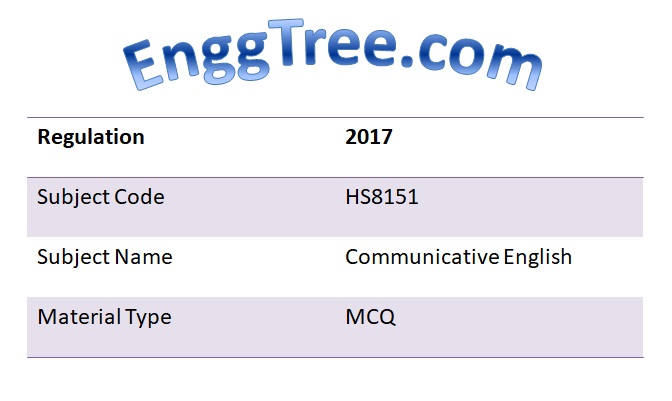
HS8151 CE MCQ’s :
We are providing the HS8151 Communicative English Multiple Choice Questions and Answers below for your examination success. use our Materials to score good marks in the examination. Best of Luck.
Department of Science & Humanities /English HS8151/COMMUNICATIVE ENGLISH QUESTION BANK
UNIT 1 –SHARING INFORMATION RELATED TO ONESELF
- MATCH THE WORDS WITH THEIR MEANINGS
I.
- emoluments – fee, for employment, salary
- drudge – Laborious work, toil
- gratuity – a small money present especially for a service given.
- steward – passengers’ attention on a ship, aircraft
II. - intact – whole; unaffected; in one piece
- tranquil – calm, peaceful
- lush – growing thickly very well
- diversity – variety having difference
III. - core – the inner most part
- coolant – cooling fluid
- breeder – production
- radiation – giving out rays
IV. - deposit – accumulation
- convoy – procession
- core – the innermost part
- indispensable – necessary
V. - spell – attraction towards something
- genius – person with creative ability
- cramped – confined within limits
- Stimulus – something that rouses people
- FILL IN THE BLANKS USING APPROPRIATE ARTICLES:
- Pope Benedict has demanded an end to electric guitars and modern music in the Vatican and return to the traditional sacred choirs.
- The triumphant Aussies are a happy lot after clinching the Warne-Muralitharan Trophy defeating Srilanka on the final day of the second test.
- Impressive performances in the just-concluded India Pakistan series have helped Sazchin Tendulkar and Yuvraj Singh go up a few notches in the latest ICC ODI ranking for batsmen.
- On International Men’s day on Monday , a group of men has sought the Ministry for their protection against abuse at home and work.
- Kenyan surgeons have amputated the arms and reconstructed the face of a herder who slew a lion, only to be mauled later by a pack of hyenas.
Fill in the gap with suitable article with option given:
a. man with a turban sat beside me.
1.a 2.an 3.the
b. I know that you are honest man.
1.a 2.the 3.an c. Principal is on rounds.
1.a 2.the 3.an
- FRAME ‘WH’ QUESTION FOR THE FOLLOWING :
(a) I am going to London.
i)Where are you going? ii)How are you going? iii)Which are you going?
(b) I like the blue dress, not the red one.
i)What dress do you like? ii)Which dress do you like? iii)Which dress do you like?
- FRAME YES OR NO QUESTIONS TO THE FOLLOWING:
- No, I like tea.
a.Do you like tea? B.Do you like coffee? C.You like tea ah? - Yes, It is raining outside.
a.Is it raining outside? B.It is raining outside. C.was it raining outside? - COMPLETE THE WORD IN THE BLANK USING THE CORRECT SUFFIX .
1.) His exemplary service in the army proves his patriot –.
i)-ness ii)ism iii) ism
b) I found a new book on dental health in the library.
i) Let ii) ish iii)worm
c) Sugar crystal very quickly
i) ism ii)izes iii)ty d)The stranger had a strange appear—–
i)ing ii)ance iii)dis - ADD SUITABLE PREFIXES TO THE FOLLOWING WORDS TO PRODUCE THEIR OPPOSITES
a) Connect
1.ir 2.dis 3.dis
b) visible
1.dis 2.in 3.nil
c) purity
1.im 2.ir 3.il
d) nutrition
1.in 2.mal 3.ir
(i) Read the following passage and answer the questions given below:
(10 marks)
(1) There are two types of diabetes, insulin-dependent and non-insulin-dependent. Between 90–95% of the estimated 13–14 million people in the United States with diabetes havenon-insulin-dependent, or Type II, diabetes. Because this form of diabetes usually begins in adults over the age of 40 and is most common after the age of 55, it used to be called adult-onset diabetes. Its symptoms often develop gradually and are hard to identify at first; therefore, nearly half of all people with diabetes do not know they have it. For instance, someone who has developed Type II diabetes may feel tired or ill without knowing why. This can be particularly dangerous because untreated diabetes can cause damage to the heart, blood vessels, eyes, kidneys, and nerves. While the causes, short-term effects, and treatments of the two types of diabetes differ, both types can cause the same long-term health problems.
(2) Most importantly, both types affect the body’s ability to use digested food for energy. Diabetes does not interfere with digestion, but it does prevent the body from using an important product of digestion, glucose (commonly known as sugar), for energy. After a meal, the normal digestive system breaks some food down into glucose. The blood carries the glucose or sugar throughout the body, causing blood glucose levels to rise. In response to this rise, the hormone insulin is released into the bloodstream and signals the body tissues to metabolize or burn the glucose for fuel, which causes blood glucose levels to return to normal. The glucose that the body does not use right away is stored in the liver, muscle, or fat.
(3) In both types of diabetes, however, this normal process malfunctions. A gland called the pancreas, found just behind the stomach, makes insulin. In people with insulin-dependent diabetes, the pancreas does not produce insulin at all. This condition usually begins in childhood and is known as Type I (formerly called juvenile-onset) diabetes. These patients must have daily insulin injections to survive. People with non-insulin-dependent diabetes usually produce some insulin in their pancreas, but their bodies’ tissues do not respond well to the insulin signal and, therefore, do not metabolize the glucose properly, a condition known as insulin resistance.
(4) Insulin resistance is an important factor in non-insulin-dependent diabetes, and scientists are searching for the causes of insulin resistance. They have identified two possibilities. The first is that there could be a defect in the insulin receptors on cells. Like an appliance that needs to be plugged into an electrical outlet, insulin has to bind to a receptor in order to function. Several things can go wrong with receptors. For example, there may not be enough receptors to which insulin may bind, or a defect in the receptors may prevent insulin from binding. The second possible cause of insulin resistance is that, although insulin may bind to the receptors, the cells do not read the signal to metabolize the glucose. Scientists continue to study these cells to see why this might happen.
(5) There’s no cure for diabetes yet. However, there are ways to alleviate its symptoms. In 1986, a National Institute of Health panel of experts recommended that the best treatment for non-insulin- dependent diabetes is a diet that helps one maintain a normal weight and pays particular attention to a proper balance of the different food groups. Many experts, including those in the American Diabetes Association, recommend that 50–60% of daily calories come from carbohydrates, 12–20% from protein, and no more than 30% from fat. Foods that are rich in carbohydrates, like breads, cereals, fruits, and vegetables, break down into glucose during digestion, causing blood glucose to rise. Additionally, studies have shown that cooked foods raise blood glucose higher than raw, unpeeled foods. A doctor or
nutritionist should always be consulted for more of this kind of information and for help in planning a diet to offset the effects of this form of diabetes.
- According to the passage, what may be the most dangerous aspect of Type II diabetes?
a. Insulin shots are needed daily for treatment of Type II diabetes.
b. Type II diabetes may go undetected and, therefore, untreated.
c. In Type II diabetes, the pancreas does not produce insulin.
d. Type II diabetes interferes with digestion. - Which of the following are the same for Type I and Type II diabetes?
a. treatments b. long-term health risks
c. short-term effects d. causes - A diet dominated by which of the following is recommended for non-insulin-dependent diabetics?
a. protein b. fat c. carbohydrates d. raw foods - Which of the following is the main function of insulin?
a. It signals tissues to metabolize sugar. b. It breaks down food into glucose.
c. It carries glucose throughout the body. d. It binds to receptors. - Which of the following is mentioned in the passage as a possible problem with insulin receptors in insulin-resistant individuals?
a. Overeating causes the receptors to function improperly.
b. There may be an overabundance of receptors present.
c. A defect causes the receptors to bind with glucose.
d. A defect hinders the receptors from binding with insulin. - Based on the information in the passage, which of the following best describes people with Type I diabetes?
a. They do not need to be treated with injections of insulin.
b. They comprise the majority of people with diabetes.
c. Their pancreases do not produce insulin.
d. They are usually diagnosed as adults.
- Your uncle who has diabetes comes to stay with you for a week and you have to look after him. Prepare a checklist of 4 items that you should check with respect to his diet and medication to make sure that his condition doesn’t become worse. (4 marks) 1.Is he taking his medicines in time? Yes/No 2.Has he eaten enough green vegetables? Yes/No 3.Have I checked his diet with ragi and wheat? Yes/No 4.Is he going for morning walk? Yes/No
| Regulation | 2017 |
| Subject Code | HS8151 |
| Subject Name | COMMUNICATIVE ENGLISH |
| Semester | I |
HS8151 Communicative English Multiple Choice Questions Answers Download Links :
| Subject | Download Links |
| HS8151 Communicative English MCQ and Answers | Click Here |
HS8151 Other Useful Links :
| HS8151 Communicative English Syllabus | Click here |
| HS8151 Communicative English Question Papers | Click here |
| HS8151 Communicative English Lecture Notes | Click here |
| HS8151 Communicative English Two Mark Questions | Click here |
| HS8151 Communicative English MCQ Questions | Click here |
| HS8151 Communicative English Question Bank | Click here |
